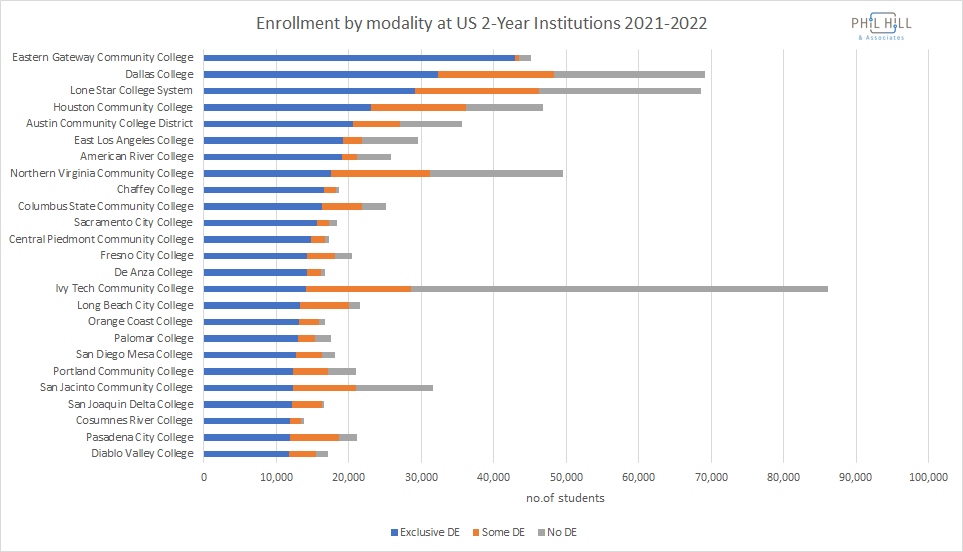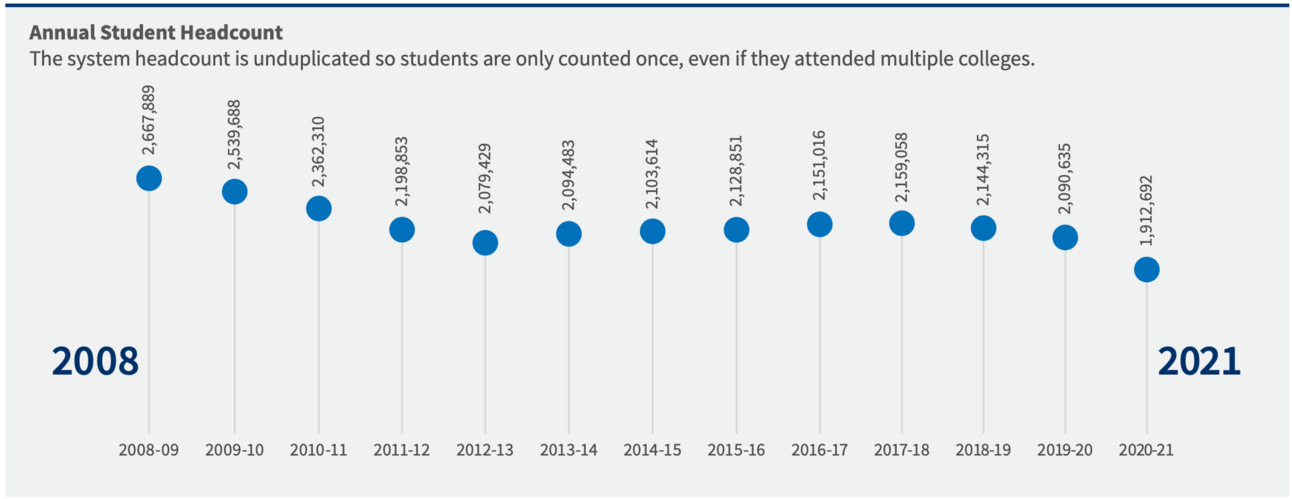Update on Online Education Growth in Community Colleges in the US
Correction, commentary, color, and California

Was this forwarded to you by a friend? Sign up, and get your own copy of the news that matters sent to your inbox every week. Sign up for the On EdTech newsletter. Interested in additional analysis? Try with our 30-day free trial and Upgrade to the On EdTech+ newsletter.
Fifteen years ago I was a member of one of the last Frye Leadership Institutes, held over two weeks at Emory University. One of the things I remember about the experience is that the folks running the institute were always encouraging us, as part of our training to be a stronger leader, to “lift up our eyes” and focus on the big picture. Under my breath I would always mutter that I needed to do the opposite. I have always been good at the big picture, but I needed to learn how to (appropriately) sweat the small stuff.
Correction
Which is a way of saying that I made an error in last week’s post on online enrollment in community colleges. Instead of the Top 25 two-year schools in terms of online enrollment, I included a chart of the top 18. Now 18 is a lucky number in several cultures, just not one that I am a member of. Here is the chart showing all 25 two-year institutions with the highest fully online enrollment. The really cool chart Phil made showing changing DE (online) enrollment over time needs no correction.

Although I shortchanged readers on no less than seven two-year institutions heavily invested in online learning, the larger point I made still stands. This means a structural change for many community colleges that will pose some interesting challenges for them, especially in the following areas:
New kinds of students, especially more non-traditional students;
Different kinds of supports and services for online learning; and
An increased need for work around retention and completion, especially for more traditional age students doing online.
This gives me an opportunity to address some of the comments made in social media about the original post and to add some additional color to the issue.
Commentary
Several commenters asked about retention and completion rates for community college students taking courses online. There isn’t a great single source of information on this issue, especially if you are trying to find more recent data. In general, the consensus seems to be that, especially for Black, Hispanic, and low-income students, taking some online courses results in better completion rates, while taking only online courses results in worse (see this research paper by Justin Ortagus as well as other research).
This apparent consensus confirms our broader conclusions above, that community colleges will need to work to address challenges associated with online enrollment. Many community colleges have made extensive progress in this space, and there are some promising practices emerging, such as those described by the Urban Institute in this report and summarized in the table below.

Another example that is broader than retention and completion (but includes it) is from the California Community College system, where the Online Education Initiative (OEI) augmented previous work in the system and increased collaboration among community colleges and helped them move online effectively and more quickly. OEI enabled a new course exchange and was a key driver behind development of a shared infrastructure for online learning. Michael Feldstein wrote about these in the predecessor to this blog, and Phil discussed them in the video below.
Color
However, more colleges will need to make the kinds of changes described above. Additional data suggest that online enrollment at community colleges will continue to increase. A survey by Bay View shows that in response to enrollment concerns, community college administrators are planning to increase the numbers of online courses.

California
Of the top 100 two-year institutions by fully online enrollment, 50 are in California. Only Texas comes close with 11 colleges in that top 100 list. While California is a large state, and it has a correspondingly large number of community colleges, those schools seem to be over-represented in terms of online enrollments. This is likely a result of three factors. First, the enlightened actions taken by individual colleges and the California Community College system with the OEI described above, which allowed the community colleges to take a leadership role with online learning, a role that they have kept (and thanks to Michelle Pacasky-Brock and others for pointing this out).
A second driver of the growth of online learning in California community colleges is the declining enrollments in California community colleges generally (and moving online to address that), as shown tin the chart below.

source: 2022 State of the System Report
The third factor contributing to the growth of online enrollments in California particularly might be due to the slowness and resistance of both the University of California and Cal State Systems to expanding online.
Parting thoughts
Given the growing interest in online courses and programs by both two-year students and institutions themselves, I expect we will see many new developments in this space over the next few years. This will not be our last word on the subject.
The main On EdTech newsletter is free to share in part or in whole. All we ask is attribution.
Thanks for being a subscriber.